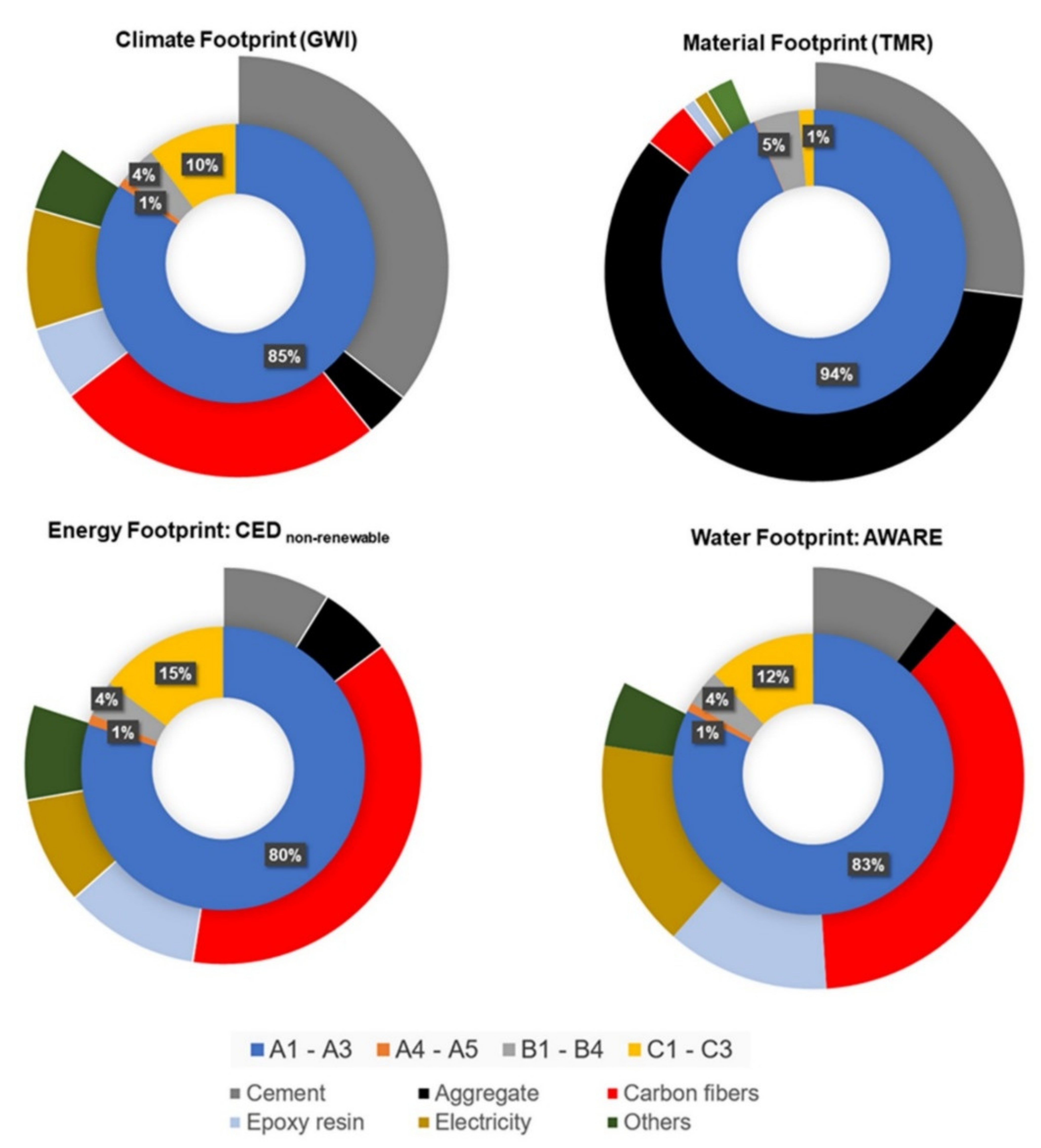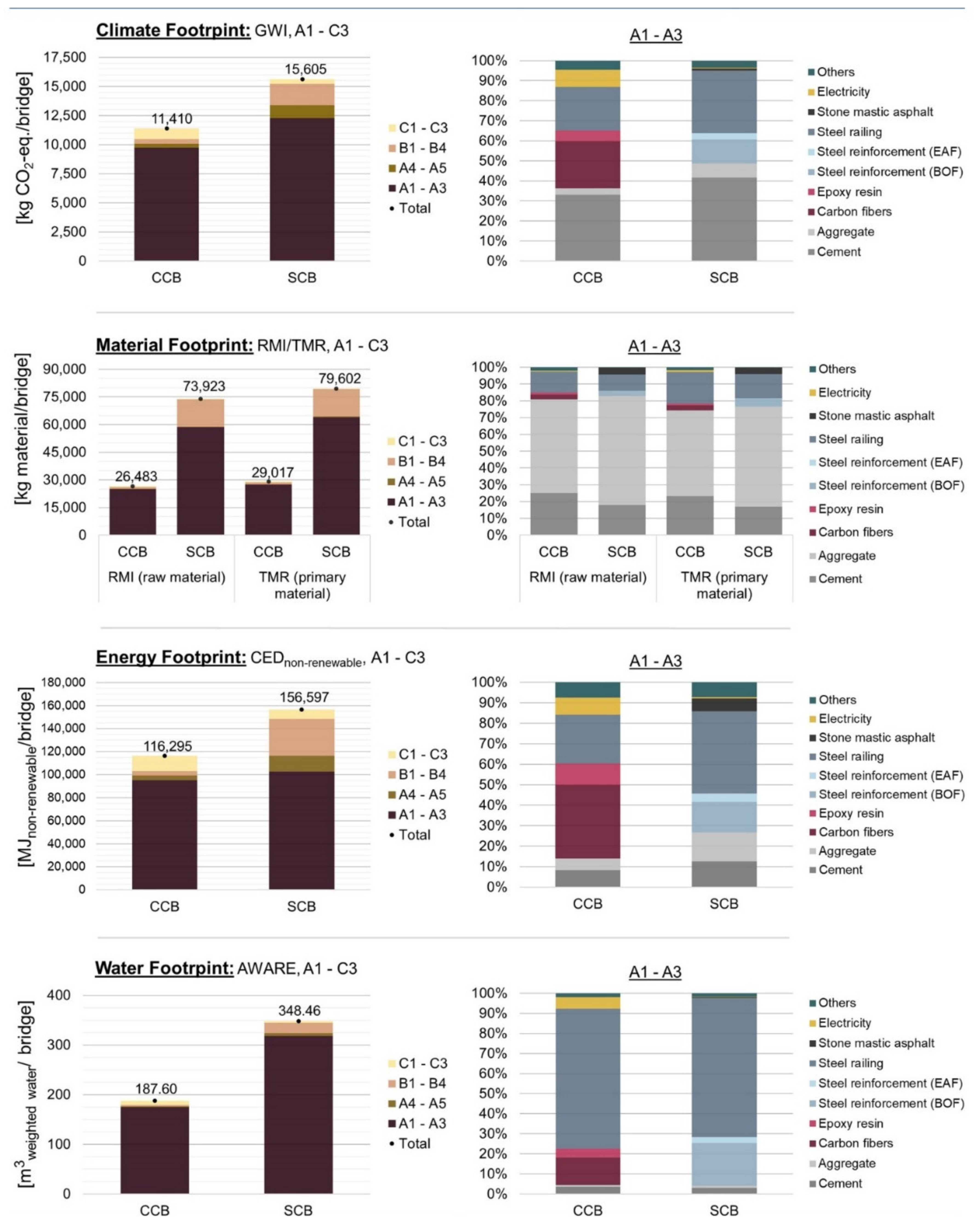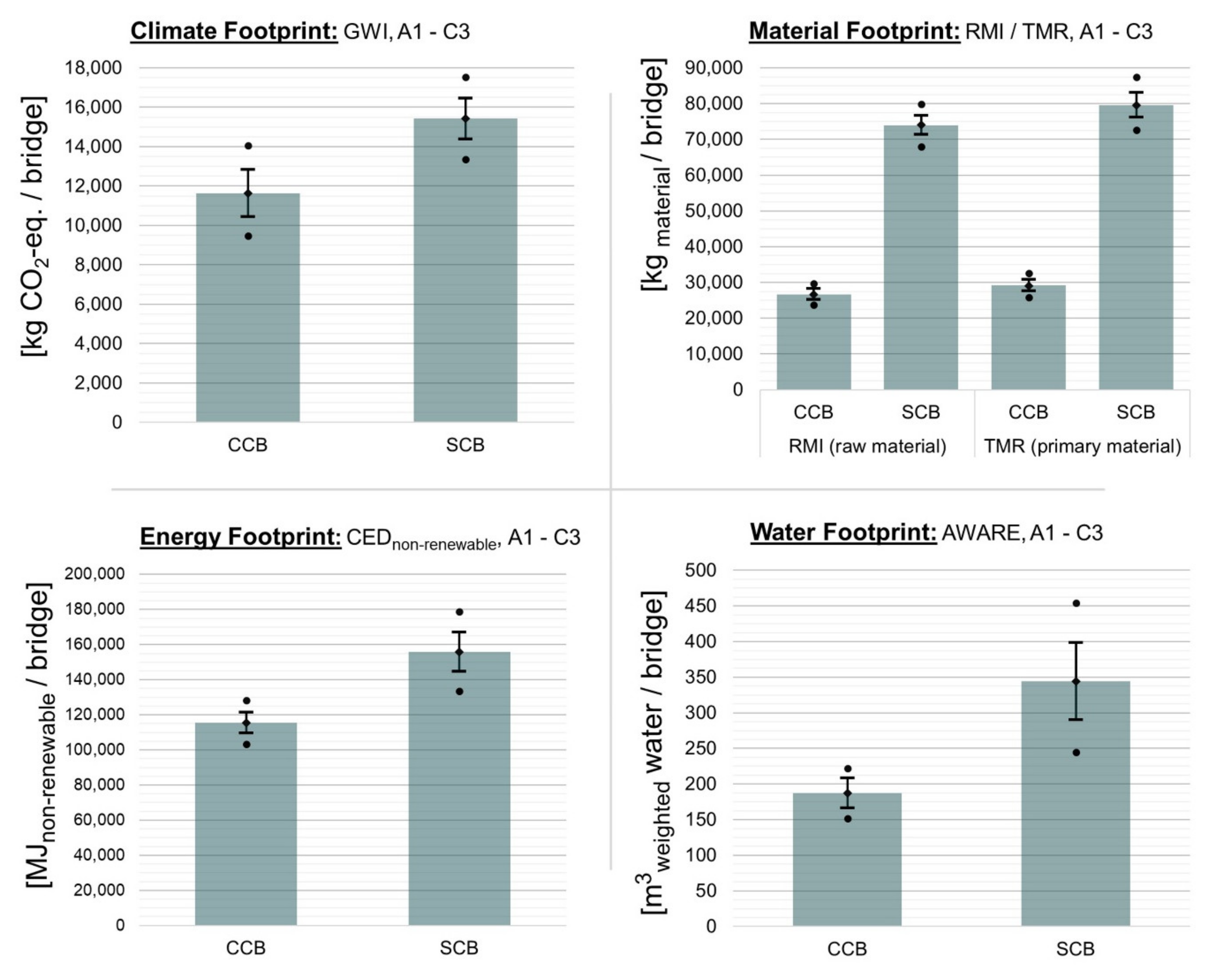Environmental Assessment of Carbon Concrete Based on Life-Cycle Wide Climate, Material, Energy and Water Footprints
Abstract
:1. Introduction
2. Materials and Methods
2.1. Life Cycle Assessment
2.2. Data
2.3. System Boundary
2.4. Footprints
2.5. Assumptions
3. Results
3.1. Footprints of Steel-Reinforced Concrete and Carbon Concrete
3.2. Footprints of a Pedestrian Bridge Made from Carbon Concrete and Steel-Reinforced Concrete
3.3. Results of the Uncertainty Analysis at the Building Level
4. Discussion
5. Conclusions
- Material footprint—64%;
- Climate footprint—27%;
- Energy footprint—26%;
- Water footprint—46%.
Author Contributions
Funding
Institutional Review Board Statement
Informed Consent Statement
Data Availability Statement
Conflicts of Interest
References
- Pales, F.A.; Leung, Y. Technology Roadmap—Low-Carbon Transition in the Cement Industry; International Energy Agency (IEA): Paris, France, 2018; Available online: https://iea.blob.core.windows.net/assets/cbaa3da1-fd61-4c2a-8719-31538f59b54f/TechnologyRoadmapLowCarbonTransitionintheCementIndustry.pdf (accessed on 3 July 2022).
- UNEP. Sand and Sustainability: Finding New Solutions for Environmental Governance of Global Sand Resources; GRID-Geneva, United Nations Environment Programme: Geneva, Switzerland, 2019; Available online: https://unepgrid.ch/storage/app/media/documents/Sand_and_sustainability_UNEP_2019.pdf (accessed on 3 July 2022).
- Bringezu, S.; Hatfield-Dodds, S.; Hellweg, S.; Schandl, H.; Clement, J.; Cabernard, L.; Che, N.; Chen, D.; Droz-Georget, H.; Ekins, P.; et al. Global Resources Outlook 2019: Natural Resources for the Future We Want. A Report of the International Resource Panel; United Nations Environment Programme: Nairobi, Kenya, 2019; Available online: https://wedocs.unep.org/bitstream/handle/20.500.11822/27517/GRO_2019.pdf (accessed on 3 July 2022).
- Parron-Rubio, M.E.; Perez-Garcia, F.; Gonzalez-Herrera, A.; Oliveira, M.J.; Rubio-Cintas, M.D. Slag Substitution as a Cementing Material in Concrete: Mechanical, Physical and Environmental Properties. Materials 2019, 12, 2845. [Google Scholar] [CrossRef] [PubMed] [Green Version]
- Miller, S.A.; John, V.M.; Pacca, S.A.; Horvath, A. Carbon dioxide reduction potential in the global cement industry by 2050. Cem. Concr. Res. 2018, 114, 115–124. [Google Scholar] [CrossRef]
- Yunchao, T.; Zheng, C.; Wanhui, F.; Yumei, N.; Cong, L.; Jieming, C. Combined effects of nano-silica and silica fume on the mechanical behavior of recycled aggregate concrete. Nanotechnol. Rev. 2021, 10, 819–838. [Google Scholar] [CrossRef]
- Yunchao, T.; Wanhui, F.; Zheng, C.; Yumei, N.; Shuhong, G.; Junbo, S. Fracture behavior of a sustainable material: Recycled concrete with waste crumb rubber subjected to elevated temperatures. J. Clean. Prod. 2021, 318, 128553. [Google Scholar] [CrossRef]
- Kortmann, J. Verfahrenstechnische Untersuchungen zur Recyclingfähigkeit von Carbonbeton; Springer: Wiesbaden, Germany, 2020. [Google Scholar] [CrossRef]
- Portal, N.W.; Lundgren, K.; Wallbaum, H.; Malaga, K. Sustainable potential of textile-reinforced concrete. J. Mater. Civ. Eng. 2015, 27, 04014207. [Google Scholar] [CrossRef]
- Lengsfeld, H.; Mainka, H.; Altstädt, V. Carbonfasern: Herstellung, Anwendung, Verarbeitung; Carl Hanser Verlag: München, Germany, 2019; ISBN 978-3-446-45407-1. [Google Scholar] [CrossRef]
- Curbach, M.; Ortlepp, R.; Scheerer, S.; Frenzel, M. Verstärken mit Textilbeton—Weg von der Vision zur Anwendung. Der Prüfingenieur 2011, 39, 32–44. Available online: https://www.bvpi.de/bvpi/downloads/der-pruefingenieur/Pruefingenieur_39.pdf (accessed on 3 July 2022).
- Laiblová, L.; Pešta, J.; Kumar, A.; Hájek, P.; Fiala, C.; Vlach, T.; Kočí, V. Environmental Impact of Textile Reinforced Concrete Facades Compared to Conventional Solutions—LCA Case Study. Materials 2019, 12, 3194. [Google Scholar] [CrossRef] [Green Version]
- Scope, C.; Guenther, E.; Schütz, J.; Mielecke, T.; Mündecke, E.; Schultze, K.; Saling, P. Aiming for life cycle sustainability assessment of cement-based composites: A trend study for wall systems of carbon concrete: Dresden Nexus Conference 2020—Session 4—Circular economy for building with secondary construction materials to minimise resource use and land use. Civ. Eng. Des. 2020, 2, 143–158. [Google Scholar] [CrossRef]
- Stoiber, N.; Hammerl, M.; Kromoser, B. Cradle-to-gate life cycle assessment of CFRP reinforcement for concrete structures: Calculation basis and exemplary application. J. Clean. Prod. 2021, 280, 124300. [Google Scholar] [CrossRef]
- DIN EN ISO 14040; Environmental management—Life cycle assessment—Principles and framework (ISO 14040:2006 + Amd 1:2020); German version EN ISO 14040:2006 + A1:2020. Deutsches Institut für Normung e.V. (DIN), Beuth Verlag: Berlin, Germany; Beuth Verlag: Berlin, Germany, 2021.
- DIN EN ISO 14044; Environmental management-Life cycle assessment-Requirements and guidelines (ISO 14044:2006 + Amd 1:2017); German version EN ISO 14044:2006 + A1:2018. Deutsches Institut für Normung e.V. (DIN), Beuth Verlag: Berlin, Germany; Beuth Verlag: Berlin, Germany, 2018.
- Klöpffer, W.; Grahl, B. Ökobilanz (LCA): Ein Leitfaden für Ausbildung und Beruf; WILEY-VCH Verlag: Weinheim, Germany, 2009; ISBN 978-3-527-32043-1. [Google Scholar]
- European Commission. ILCD Handbook: General Guide for Life Cycle Assessment—Detailed Guidance, 1st ed.; Handbook of the Joint Research Centre–Institute for Environment and Sustainability (EC-JRC-IES), Ed.; European Commission: Luxemburg, 2010; Available online: https://eplca.jrc.ec.europa.eu/uploads/ILCD-Handbook-General-guide-for-LCA-DETAILED-GUIDANCE-12March2010-ISBN-fin-v1.0-EN.pdf (accessed on 3 July 2022)ISBN -.
- Sameer, H.; Weber, V.; Mostert, C.; Bringezu, S.; Fehling, E.; Wetzel, A. Environmental Assessment of Ultra-High-Performance Concrete Using Carbon, Material, and Water Footprint. Materials 2019, 12, 851. [Google Scholar] [CrossRef] [Green Version]
- Lünser, H. Ökobilanzen im Brückenbau—Eine Umweltbezogene, Ganzheitliche Bewertung; Birkhäuser Verlag: Basel, Switzerland, 1999; ISBN 978-3-7643-5946-1. [Google Scholar]
- Curbach, M.; Jesse, F. Eigenschaften und Anwendung von Textilbeton. Beton-und Stahlbetonbau. Beton- Und Stahlbetonbau 2009, 104, 9–16. [Google Scholar] [CrossRef]
- Schladitz, F.; Curbach, M. Carbon Concrete Composite. In Neue Herausforderungen im Betonbau; Holschemacher, K., Ed.; Beuth Verlag: Berlin, Germany, 2017; pp. 121–138. ISBN 978-3-410-27393-6. [Google Scholar]
- König, G.; Tue, N.V.; Zink, M. Hochleistungsbeton: Bemessung, Herstellung und Anwendung; Ernst & Sohn Verlag: Berlin, Germany, 2001; ISBN 3-433-01738-7. [Google Scholar]
- Küchlin, D.; Hersel, O. Betontechnische Daten; Heftausgabe, Ed.; HeidelbergCement AG: Leimen, Germany, 2017; Available online: https://www.heidelbergcement.de/de/system/files_force/assets/document/91/6a/btd_heft-ausg2017-10102018.pdf?download=1 (accessed on 3 July 2022).
- Seifert, W.; Lieboldt, M. Ressourcenverbrauch im globalen Stahlbetonbau und Potenziale der Carbonbetonbauweise. Beton- Und Stahlbetonbau 2020, 115, 469–478. [Google Scholar] [CrossRef]
- Werdin, S. Ingenieurtechnische Bewertung Ausgeführter Projekte aus Carbonbeton; Diplomarbeit, Technische Universität Dresden, Institut für Massivbau: Dresden, Germany, 2018. [Google Scholar]
- Becke, A.; Reiners, J.; Sülün, C. Erläuterungen zu den Umweltproduktdeklarationen für Beton; EPD der InformationsZentrum Beton GmbH, Ed.; Verlag Bau+Technik: Düsseldorf, Germany, 2014; Available online: https://betonshop.de/media/wysiwyg/PDF/epd_broschuere_2014.pdf (accessed on 3 July 2022).
- Helbig, T.; Unterer, K.; Kulas, C.; Rempel, S.; Hegger, J. Fuß-und Radwegbrücke aus Carbonbeton in Albstadt-Ebingen: Die weltweit erste ausschließlich carbonfaserbewehrte Betonbrücke. Beton- Und Stahlbetonbau 2016, 111, 676–685. [Google Scholar] [CrossRef]
- Kulas, C. Verstärken mit Textilbeton nach abZ Z-31.10-182. Die Planermappe. Fußgängerbrücke (Albstadt-Ebingen); TUDALIT Leichter bauenZukunft formen: Dresden, Germany, 2016; pp. 5–12. Available online: http://tudalit.de/wp-content/uploads/2018/05/Planermappe.pdf (accessed on 3 July 2022).
- DIN EN 15804; Nachhaltigkeit von Bauwerken—Umweltproduktdeklarationen—Grundregeln für die Produktkategorie Bauprodukte—Deutsche Fassung EN 15804:2012+A1:2013. Deutsches Institut für Normung e.V. (DIN): Berlin, Germany; Beuth Verlag: Berlin, Germany, 2014.
- Myhre, G.; Shindell, D.; Bréon, F.-M.; Collins, W.; Fuglestvedt, J.; Huang, J.; Koch, D.; Lamarque, J.-F.; Lee, D.; Mendoza, B.; et al. Anthropogenic and Natural Radiative Forcing. In Climate Change 2013: The Physical Science Basis. Contribution of Working Group I to the Fifth Assessment, Report of the Intergovernmental Panel on Climate Change; Cambridge University Press: Cambridge, UK, 2013. [Google Scholar] [CrossRef]
- Mostert, C.; Bringezu, S. Measuring product material footprint as new life cycle impact assessment method: Indicators and abiotic characterization factors. Resources 2019, 8, 61. [Google Scholar] [CrossRef] [Green Version]
- Bringezu, S.; Kaiser, S.; Turnau, S.; Mostert, C. Bestimmung des Materialfußabdrucks mit Ökobilanziellen Methoden und Softwarelösungen; Center for Environmental System Research (CESR), Ed.; Center for Environmental System Research (CESR): Kassel, Germany, 2019. [Google Scholar] [CrossRef]
- VDI. Kumulierter Energieaufwand (KEA) Begriffe, Berechnungsmethoden; Richtlinie vom Verein Deutscher Ingenieure e.V.: Düsseldorf, Germany, 2012. [Google Scholar]
- Bringezu, S.; Ritthoff, M.; Steger, S.; Bahn-Walkowiak, B. Rohstoffversorgung und Ressourcenproduktivität in der Deutschen Zementindustrie: Analysen des Status quo und Perspektiven; Studie zur Initiative für Nachhaltigkeit in der deutschen Zementindustrie: Wuppertal, Germany, 2015; Available online: https://www.zement-verbindet-nachhaltig.de/images/studien/Studie_Rohstoffversorgung_Ressourcenproduktivit%C3%A4t_Zementindustrie.pdf (accessed on 3 July 2022).
- Baitz, M.; Colodel, C.M.; Kupfer, T.; Florin, J.; Schuller, O.; Hassel, F.; Kokborg, M.; Köhler, A.; Thylmann, D.; Stoffregen, A.; et al. Gabi Database & Modelling Principles 2013, Version 1.0; PE International AG: Echterdingen, Germany, 2013; Available online: https://gabi.sphera.com/uploads/media/GaBi_Modelling_Principles_2013.pdf (accessed on 3 July 2022).
- Huijbregts, M.A.; Rombouts, L.J.; Hellweg, S.; Frischknecht, R.; Hendriks, A.J.; Van de Meent, D.; Ragas, A.M.; Reijnders, L.; Struijs, J. Is cumulative fossil energy demand a useful indicator for the environmental performance of products? Environ. Sci. Technol. 2006, 40, 3. [Google Scholar] [CrossRef] [Green Version]
- Boulay, A.M.; Bare, J.; Benini, L.; Berger, M.; Lathuillière, M.J.; Manzardo, A.; Margin, M.; Motoshita, M.; Núñez, M.; Pastor, A.V.; et al. The WULCA Consensus Characterization Model for Water Scarcity Footprints: Assessing Impacts of Water Consumption Based on Available Water Remaining (AWARE). Int. J. Life Cycle Assess. 2018, 23, 368–378. [Google Scholar] [CrossRef] [Green Version]
- WULCA Working Group. Download AWARE Factors, Download (Sub) Watershed Level Values (Annual and Monthly); UNEP Life Cycle Initiative: Paris, France, 2016; Available online: https://wulca-waterlca.org/aware/download-aware-factors (accessed on 3 July 2022).
- Gogolin, D. SMA—Eine Asphaltsorte und Ihre Anwendung; Präsentation der Informationsveranstaltung vom Deutschen Asphaltverband (DAV): Essen, Germany, 2015; Available online: https://www.asphalt.de/fileadmin/user_upload/asphaltberatung/downloads/essen_sma.pdf (accessed on 3 July 2022).
- Cuntze, R. Fachbegriffe für Kompositbauteile—Technical Terms for Composite Parts: Glossar für Bauwesen und Maschinenbau–Glossary for Civil- and Mechanical Engineering; Springer: Wiesbaden, Germany, 2019; Available online: https://link.springer.com/content/pdf/10.1007%2F978-3-658-25635-7.pdf (accessed on 3 July 2022).
- Mostert, C.; Sameer, H.; Glanz, D.; Bringezu, S. Climate and resource footprint assessment and visualization of recycled concrete for circular economy. Resour. Conserv. Recycl. 2021, 174, 105767. [Google Scholar] [CrossRef]
- Mostert, C.; Sameer, H.; Glanz, D.; Bringezu, S.; Rosen, A. Neubau aus Rückbau–Wissenschaftliche Begleitung der Planung und Durchführung des selektiven Rückbaus eines Rathausanbaus aus den 1970er-Jahren und der Errichtung eines Neubaus unter Einsatz von Urban Mining (RückRat); BBSR-Online-Publikation: Bonn, Germany, 2021; Available online: https://www.bbsr.bund.de/BBSR/DE/veroeffentlichungen/bbsr-online/2021/bbsr-online-15-2021-dl.pdf?__blob=publicationFile&v=3 (accessed on 3 July 2022).
- Gerbens-Leenes, P.W.; Hoekstra, A.Y.; Bosman, R. The blue and grey water footprint of construction materials: Steel, cement and glass. Water Resour. Ind. 2018, 19, 1–12. [Google Scholar] [CrossRef]
- Spelter, A.; Bergmann, S.; Bielak, J.; Hegger, J. Long-Term Durability of Carbon-Reinforced Concrete: An Overview and Experimental Investigations. Appl. Sci. 2019, 9, 1651. [Google Scholar] [CrossRef]
- Yang, J.; Liu, J.; Liu, W.; Wang, J.; Tang, T. Recycling of carbon fibre reinforced epoxy resin composites under various oxygen concentrations in nitrogen–oxygen atmosphere. J. Anal. Appl. Pyrolysis 2015, 112, 253–261. [Google Scholar] [CrossRef]
- Kimm, M.; Gerstein, N.; Schmitz, P.; Simons, M.; Gries, T. On the separation and recycling behaviour of textile reinforced concrete: An experimental study. Mater. Struct. 2018, 51, 122. [Google Scholar] [CrossRef]
- Haidar, L. Stahl: Sein zweites Leben. Unbegrenztes Recycling—Ohne Qualitätsverlust. Greenbuilding 2015, 7–8, 22–25. [Google Scholar]
- Rempel, S. Ökobilanz der Carbonbetonbrücke in Ebingen. In Proceedings of the Carbon- und Textilbetontage, Dresden, Germany, 22–23 September 2020; TUDALIT Leichter Bauen—Zukunft Formen: Dresden, Germany, 2020; pp. 10–11. Available online: https://www.carbon-textilbetontage.de/wp-content/uploads/2020/09/2020-09-28_Gesamt_final.pdf (accessed on 3 July 2022).
- DIN EN 15978; Sustainability of Construction Works—Assessment of Environmental Performance of Buildings—Calculation Method. Deutsches Institut für Normung e.V. (DIN): Berlin, Germany; Beuth Verlag: Berlin, Germany, 2012.
- Kulas, C. Zum Tragverhalten Getränkter Textiler Bewehrungselemente für Betonbauteile. Ph.D. Thesis, Lehrstuhl und Institut für Massivbau der RWTH Aachen, Aachen, Germany, 2013. Available online: http://publications.rwth-aachen.de/record/229800/files/4943.pdf (accessed on 3 July 2022).
- Pinzek, A. Untersuchungen zum Verankerungsverhalten Getränkter Textiler Bewehrungselemente. Master’s Thesis, Fakultät für Bauingenieurwesen der Technischen Universität Wien, Vienna, Austria, 2020. [Google Scholar] [CrossRef]
- Turnau, S.; Mignot, C.S.; Mostert, C.; Bringezu, S. Material or fuel: Comparative cradle-to-grave climate and material footprint analysis for the use of methanol from recycled CO2. Green Chem. 2020, 22, 8423–8443. [Google Scholar] [CrossRef]




| Material | Unit | 1 m3 Concrete | |
|---|---|---|---|
| C70/85 | C35/45 | ||
| Cement | kg/m3 | 500 | 356 |
| Aggregates | kg/m3 | 1700 | 1808 |
| -Gravel | kg/m3 | 1105 | 796 |
| -Sand | kg/m3 | 595 | 635 |
| -Crushed stones | kg/m3 | - | 377 |
| Water | kg/m3 | 183.4 | 165 |
| Fly ash | kg/m3 | 60 | 47 |
| Silica fume | kg/m3 | 35 | - |
| Additives | kg/m3 | 15 | 1.8 |
| Total | kg/m3 | 2493.4 | 2377.8 |
| Category | Climate Footprint | Material Footprint | Material Footprint | Energy Footprint | Water Footprint |
|---|---|---|---|---|---|
| Indicator | GWI | RMI | TMR | CEDnon-renewable | AWARE |
| Unit | kg CO2-eq./m3 | kgraw material/m3 | kgprimary material/m3 | MJnon-renewable/m3 | m3weighted water/m3 |
| steel-reinforced concrete | 611 | 3530 | 3640 | 4409 | 7.00 |
| carbon concrete | 1390 | 3591 | 3657 | 13,921 | 9.92 |
Publisher’s Note: MDPI stays neutral with regard to jurisdictional claims in published maps and institutional affiliations. |
© 2022 by the authors. Licensee MDPI, Basel, Switzerland. This article is an open access article distributed under the terms and conditions of the Creative Commons Attribution (CC BY) license (https://creativecommons.org/licenses/by/4.0/).
Share and Cite
Mostert, C.; Bock, J.; Sameer, H.; Bringezu, S. Environmental Assessment of Carbon Concrete Based on Life-Cycle Wide Climate, Material, Energy and Water Footprints. Materials 2022, 15, 4855. https://doi.org/10.3390/ma15144855
Mostert C, Bock J, Sameer H, Bringezu S. Environmental Assessment of Carbon Concrete Based on Life-Cycle Wide Climate, Material, Energy and Water Footprints. Materials. 2022; 15(14):4855. https://doi.org/10.3390/ma15144855
Chicago/Turabian StyleMostert, Clemens, Jannik Bock, Husam Sameer, and Stefan Bringezu. 2022. "Environmental Assessment of Carbon Concrete Based on Life-Cycle Wide Climate, Material, Energy and Water Footprints" Materials 15, no. 14: 4855. https://doi.org/10.3390/ma15144855
APA StyleMostert, C., Bock, J., Sameer, H., & Bringezu, S. (2022). Environmental Assessment of Carbon Concrete Based on Life-Cycle Wide Climate, Material, Energy and Water Footprints. Materials, 15(14), 4855. https://doi.org/10.3390/ma15144855






